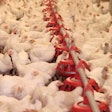
Although meat trade around the world is projected to slow over the next decade, the largest increases in volume remain to be seen in the poultry sector. World meat exports in 2024 are projected by the Food and Agriculture Organization (FAO) to sit 25 percent above the base period level in 2012-14, growing just 2.2 percent compared to an annual average rate of 3.8 percent growth over the previous decade, mostly slowing due to increasing domestic meat production in developing countries that have historically been larger importers. For poultry meat, the world’s export growth is projected to slow to 2.81 percent over the coming outlook period, significantly lower than the 5.75 percent growth rate experienced over the previous decade. Lower export growth percentages in Europe and Africa will largely contribute to this overall slowing.
In 2024, developed countries are expected to account for less than half of global meat exports, with the U.S. share at nearly 30 percent for all meats. Poultry meat exports by developed countries in 2024 are projected at 7.7 million metric tons, while developing countries’ majority share will total more than 9 million metric tons. For the world’s largest poultry meat exporter, the U.S., poultry meat exports are projected to grow from almost 3.7 million metric tons in 2014 to 4.3 million metric tons by 2024. Likewise, exports from Brazil are projected by FAO to grow over the outlook period, benefiting from strong international demand boosted by the Brazilian real’s ongoing depreciation. China will remain a net exporter through 2024, importing just 2 percent of consumption. China’s poultry exports and imports are projected to increase by 31 percent and 12 percent, respectively, by 2024.
On the other hand, strong demand for poultry meat imports worldwide is expected over the outlook period, reflecting the diversification of diets in developing countries toward greater consumption of calories from animal protein. Poultry will benefit greatly from this diet shift, with FAO projecting imports of just over 16 million metric tons in 2024. Poultry products remain less expensive than beef or pork, further stimulating demand. Countries such as Mexico and those in the Central America and Caribbean regions will also see an increase in poultry meat demand and imports on account of higher wages. Mexico’s domestic poultry production continues to increase during the projection period, but it rises less than consumption resulting in a rise in imports by about 0.5 million metric tons or 52 percent. The majority of the the largest importing countries and regions from the U.S. over the outlook period are located in Africa, Asia and the Middle East.
In the U.S., a major producer and consumer of poultry meat and eggs, poultry trade volume for broiler meat is projected by the U.S. Department of Agriculture (USDA) to grow in the near term from 2014 through 2016. For turkey meat, trade volume slipped in the U.S. in 2015 after the country’s outbreak of avian influenza, which hit turkey producers in the Midwest hardest, led other countries to ban U.S. imports, but it is projected to recover slightly by the end of 2016 to more than 6 million pounds. The same is true of the country’s egg trade volume, as layer farms were also hit by avian influenza.
Main trade issues and uncertainties in world meat markets
According to FAO, trade policies remain one of the factors that will have the greatest impact on trade of poultry products over the next decade. The implementation of several bilateral trade agreements could diversify trade considerably, FAO says. For example, a recently negotiated China-Australia Free Trade Agreement would likely provide increased access to Chinese meat markets for Australia. Another risk factor is domestic policies, as in the case of poultry meat trade in Russia. In 2014, Russia imposed a one-year ban on imports of food from the U.S., Australia, Norway, Canada and the European Union in response to economic sanctions. After this ban, Brazil’s share of imports to Russia increased from 9.8 percent in 2013 to just over 25 percent in 2014. The ban on meat imports from these same countries was extended through August 5, 2016, but FAO assumes this ban will only temporarily disrupt trade flows. Another uncertainty continues to be the risk of animal disease outbreaks like avian influenza and the impact of vaccination or non-vaccination on trade.
View interactive charts and download the datasets in the Market Data section of WATTAgNet:
Poultry meat trade in developed and developing countries in 2024
Poultry meat export projections for top 5 countries to 2024
World poultry meat import volume growth to 2024
Poultry meat import volume projections by country to 2024
Monthly poultry imports in Russia 2014
Poultry meat export growth volumes and percentages by world region 2012-14 to 2024

















